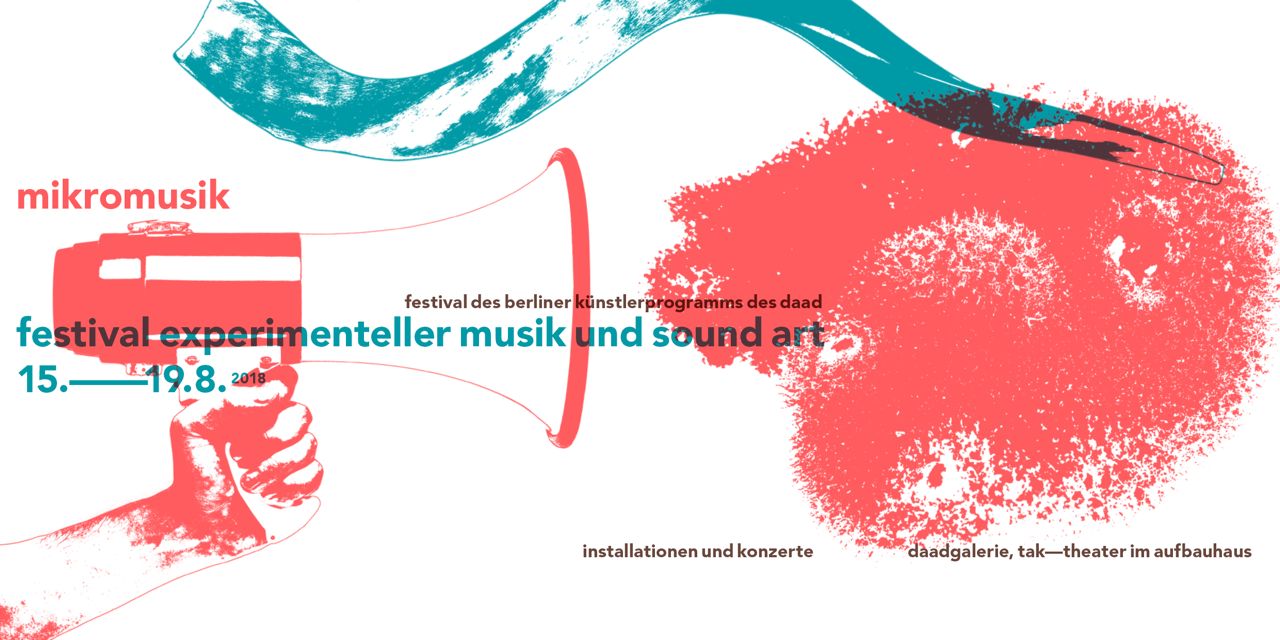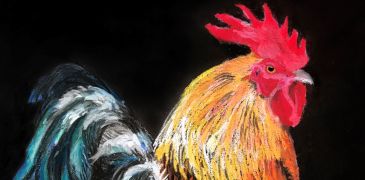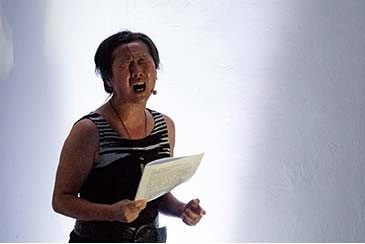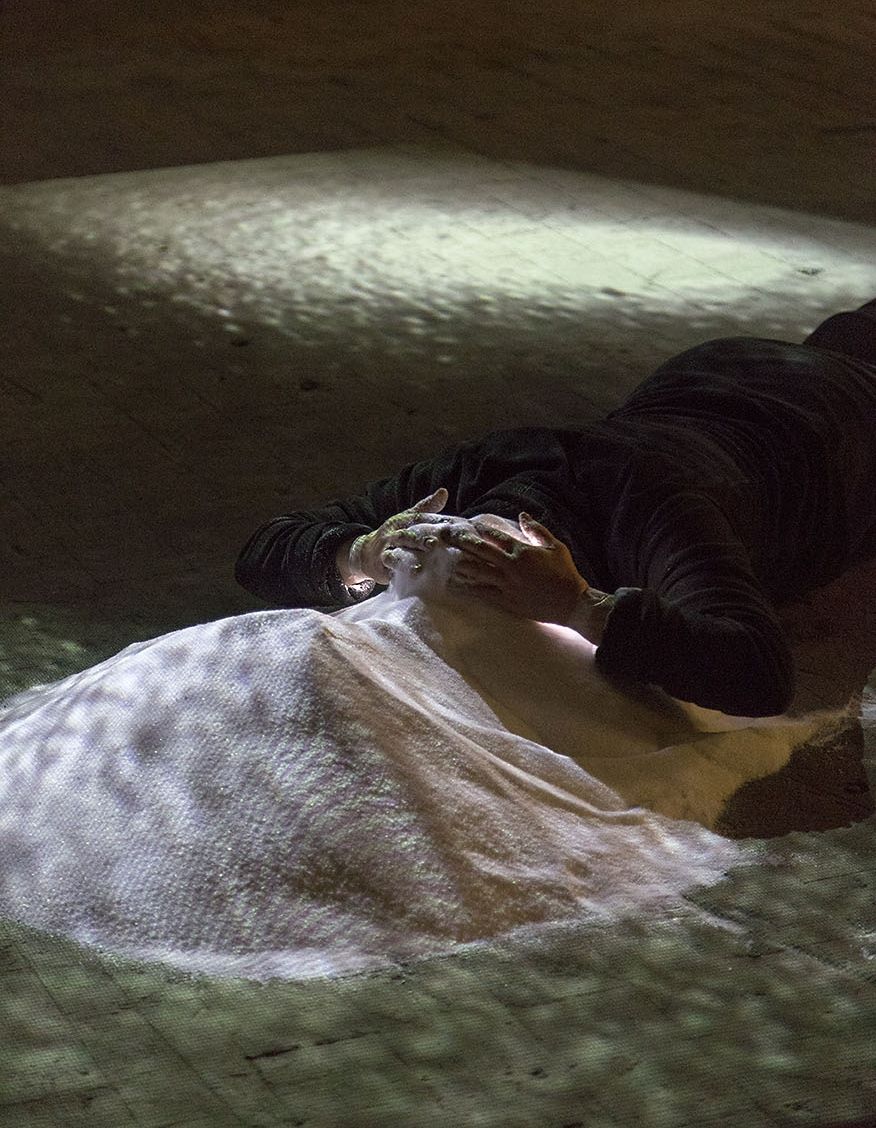Taiwan, Music, 2018
Liping
Ting
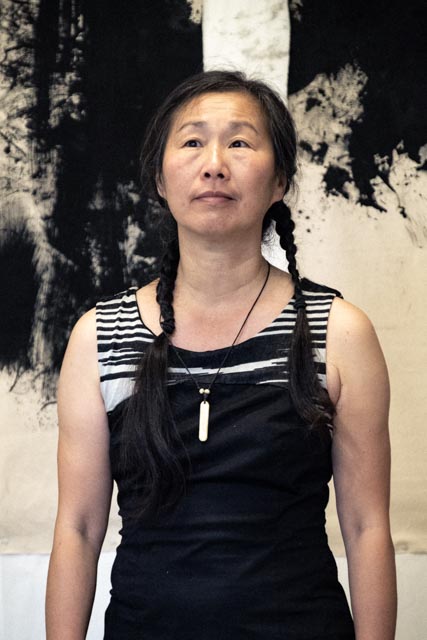
Slowness is a challenge. In the works of Liping Ting it is ubiquitous. In “Paper Timing”, a pile of crumpled leaves begins trembling as if in slow motion. Liping Ting, hiding under the paper, controls her movements like an extreme athlete. The Taiwanese-born artist is present in nearly all her works, but rarely as concealed as in this case.
Liping Ting is a performance artist who works with her own body. Accordingly, the boundary between herself and her art is porous. In “Stone Timing”, she balances a heavy stone on her head while clasping a white feather between her teeth. Except for a cap that also covers the eyes, she stands nude and still, her Body painted with Chinese ink, between the gallery visitors. As if in slow motion, she spins gradually around on her own axis, coiling herself in long white threads stretching from her cap out into the room. Later, she will roll around in soil, cover herself in black ink, and use her body to create pictures on white paper. All these actions are performed with the same concentration and slowness she uses when balancing the stone on her head. In an interview, Liping Ting mentions that she meditates for seven hours before performing for an hour. Her extremely concentrated and decelerated actions border on trance states.
Stone and feathers are leitmotifs in the work of Liping Ting. In some works, she also balances forked branches, giant plastic bags, or water-filled glass cylinders on her head, but stones and feathers are the most prominent and significant elements in her iconography. They accompany her like the attributes in hermit practice. Fellow artist Serge Pey describes her as an artist situated “between feather and stone.” The balancing of the stone—at times there are also several—is more than just a circus act performed by an equilibrist. The feather contrasts the weight of the stone that threatens to fall with the lightness and image of flying. At the same time, the feather—clasped between the teeth—prevents clear enunciation and serves as the medium of communication when she touches the audience with it. Before the performance, explains Serge Pey, “she chews for a long time on the quill of the feather, which she uses to come into contact with viewers. Like a shaman, she infuses the feather with her energy in order to connect with the soul of the other, who, via contact, ceases being an observer and instead becomes a participant in a secret and enigmatic ritual.”
In her work, Liping Ting increasingly transcends the border between performative stage and audience. Sometimes she places a small cube of sugar on viewers’ heads or records their voices and plays them back in the room. She whispers messages into the ears of those present or has them hold one of the heavy stones. In the collective work “Sonarium”, she integrates viewers into the game by having them hold and pass around the sound-emitting objects together. In her solo Installation ”Mur de Murmure” she incorporates the visitors into the game of perception by different unknown gaze and inner breathing listening.
The works of Liping Ting combine dance, ritual, video art, photography, sound art, and poetry. She often uses the term “poésie d’action.” She came into contact with dance early on, including traditional Chinese dance traditions, through her mother. She first studied philosophy in Taipei. In 1988 she went to France, where she studied “Etudes theatrales” (applied theater studies) initially in Besançon and then at the Sorbonne in Paris. Her graduation thesis explored a link between Samuel Beckett’s theatrical work on the interdisciplinary art forms of the 1950s and the work of John Cage. Above, her work is ruminating the philosophy of the Chinese poet and philosopher Zhuang-Zi.
The acoustic dimension of her own work manifested itself in early stage performances such as “inouïr” (2005), where she dances, shouts, and sings with a metal bucket clattering on her head to a sound composition. Sound material is an integral part of her work. The sounds of her breathing and the murmur and whisper of her voice accompany her performances. She tosses metal objects on the floor, or works with the squeaking and tearing of plastic, for example, when enacting—wrapped in several layers of transparent plastic sheeting—an embryonic, claustrophobic choreography on the floor of a gallery. Not infrequently she plays with the question whether sounds are live or recorded. Even the mountain of paper she moves centimeter by centimeter across the floor in Paper Timing produces a rustling sound. Her expressive mediums include sound art, music, and language. At the Canadian performance festival RIAP in September 2016, she invited the audience to join in a mad group dancing. Surrounded by her screaming absurd questions, the participants run and danced. The double spiral of the group (compression and dilatation movement) as well as the group acceleration created an emancipatory collective movement. Liping Ting repeated the questions: “Do you believe that the world has a future? Do you believe that art has a future?” With a branch balancing on her head, bringing her request to the reality of the world, the artist left the room at the end of the performance.
In her synthesizing of spirit, body, and mind Liping Ting’s poetic actions follow in the tradition of shamanistic works by artists such as Marina Abramović or Joseph Beuys. And they prove how far into the future Marcel Duchamp saw when he wrote: “Today, the artist is a curious reservoir of para-religious values, absolutely in opposition to the daily functionalism for which science receives the homage of a blind worship.”
Text: Martina Seeber & Liping Ting
Translation: Erik Smith


